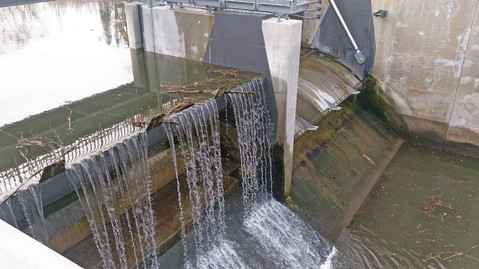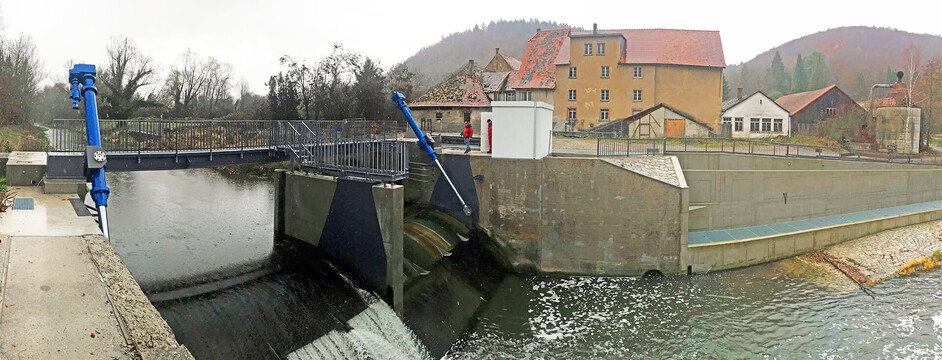
Replacement of Stuhlmüller weir on the river Pfinz, technical equipment
Starting position
The Stuhlmüller weir system, built in 1969 and completed in 1971 as part of the Pfinz correction, is located in Pfinztal-Berghausen and has a weir flap that replaced the previous weir with lifting contactors. After more than 40 years in use, the plant has become outdated with deformations occurring on the weir flap, which were further aggravated by the flood in June 2016. As a result, a structural and functional test and then an analysis of the statics were initiated in the autumn of 2016. It turned out that even during normal backwater, the stability of the weir flap could no longer be guaranteed and that no corrosion protection existed, that the flap was heavily rusted and components were missing. Furthermore, the drive did not comply with any of the current safety levels. This made it necessary to completely lower the weir gate, making it impossible to dam up the corresponding section of the Pfinz. Since the flap could no longer be repaired and it was impossible to rebuild the entire weir system without damaging the vegetation and buildings, the weir flap had to be replaced entirely.
A fish ladder was also incorporated into the weir, but it was no longer in a functioning state and was therefore replaced by a new one. Schnellermühle mill is located at the top of the weir and generates energy that also powers the weir itself.
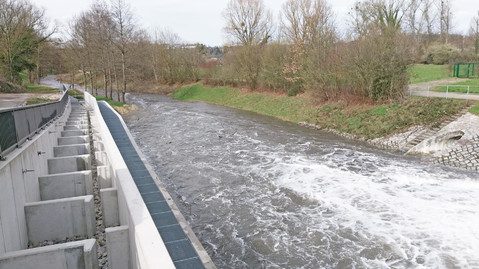
The Task
Part of the assignment involved performing a study of variants with regard to technical and economic aspects. Different lock types were considered as variants with one or two weir fields and different drive concepts and inspection locks. A division into two weir fields with fish-bellied flaps as the closing element was chosen as a preferred variant. Each of the two flaps is driven on one side by an electric lifting cylinder. The existing drive house will be replaced by a new building.
We were commissioned with planning all the electrical equipment for replacing the Stuhlmüller weir.
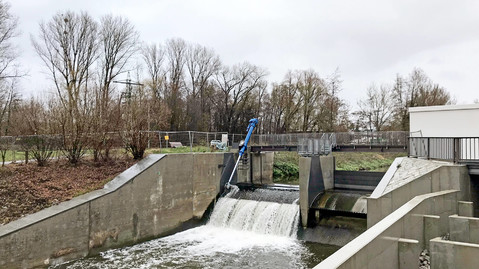
Services
The power supply for the weir has been redesigned so it does not come from Schnellermühle mill anymore, but from the 400 V grid. The drives and weir fields along with the heating and building installations are supplied with electricity with the aid of the low-voltage main distribution board. Furthermore, all the requisite cable routes were planned and the corresponding cable lengths calculated. In the event of a power failure, the failsafe was to feed into the LVMD over a mobile emergency power generator. A UPS is used to bridge short interruptions and prevent controls, sensors and sensitive devices from having to be restarted.
Each of the two weir fields was equipped with an electric lifting cylinder (approx. 6 kW each). A frequency converter supplies each of the motors with power. A programmable logic controller is used to control the weir system and the heating for the lateral abrasive surfaces, which allows for automatic or manual control. Operation takes place over a control panel on the control cabinet in the drive house. The overall control cabinet requirements were determined for the drive house. The automation technology has been purposefully designed and the telecommunications technology involves notification by telephone or text message.
An earthing concept was developed for the weir system, which did not include external lightning protection for the drive house for none is needed due to its small size. The surge protection and equipotential bonding were also planned according to the current state of the art. Our assignment included site supervision, reviewing the operating and maintenance manual and workshop plans, and drawing up a service and maintenance concept. A risk assessment in accordance with the Machinery Directive was also carried out for the new construction.
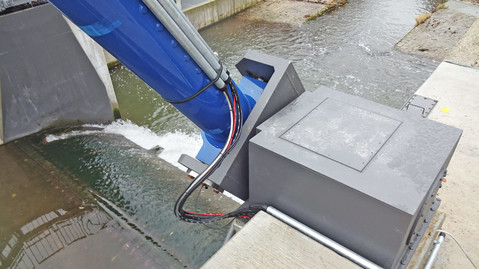
Challenges and special features
Both the planning and the construction period for this project were very tight. Regular communication with Schnellermühle mill also took place to keep the water level sufficiently high so that the water turbines could be operated as efficiently as possible.
